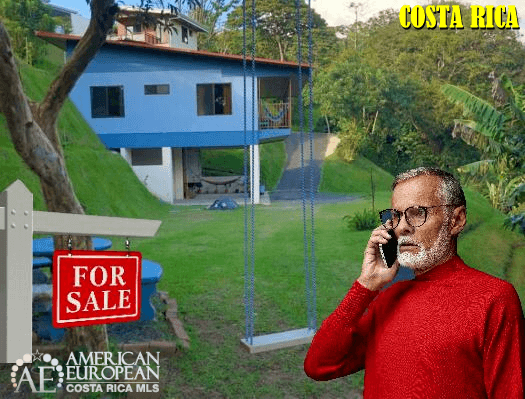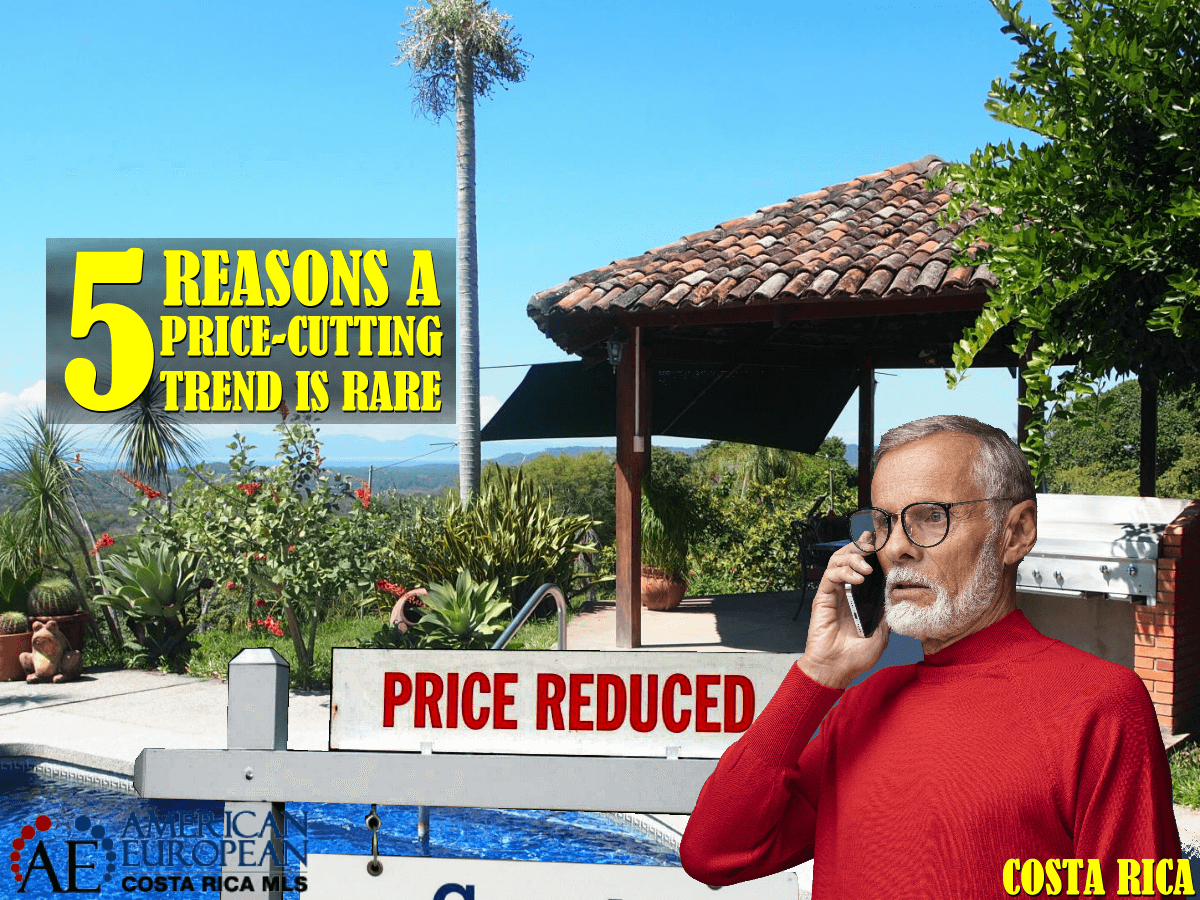Estimated Reading Time: 7 Minutes
Why is a price-cutting trend so rare in Costa Rica real estate? There are several reasons.
In typical real estate markets, it’s a buyer’s market when the inventory is high, and it’s a seller’s market when the inventory is low, right?
Well, the Costa Rican real estate market is not conventional and doesn’t depend on trends. And price cutting is rarely an option for most sellers. I have seen sellers prefer to lose their property in foreclosure than cutting their asking price.
Some local websites proudly advertise some of their price-trend tools, but if you take a good look at them, you’ll find them useless. That happens because our market differs from other countries in many ways.
First, our country is so small that anything that creates a trend elsewhere will not make any, or very little, impact on our market.
Second, the beach real estate market here behaves differently than the Central Valley market.
Third, it’s impossible to create statistics for lack of data. In Costa Rica, you will not be able to find the latest housing indicators, a housing affordability index, a pending home sales snapshot, an existing home sales snapshot, or local market reports. Weird eh!
Fourth, many sellers of older homes are not realistic about the market value of their homes because they have already paid their mortgage.
Fifth, since 2010, real estate developers and banks have financed millennials 100% of their real estate purchases in the Central Valley. However, due to the high inventory, property prices have not been appreciated enough for them to be able to sell at a reduced price.
I will dive a little more into these 5 critical facts below, so you can understand our market a little better before you start making low-ball offers left and right.

1. Small country
First, our country is so small that anything that creates a trend elsewhere will not make any, or very little, impact on our market. Here, for example, cities do not compete to attract industry so they can grow. So if someone lives in San Ramon and obtains a job in Cartago, which is a more than 2-hour drive, that person will not sell the home in San Ramon and buy one in Cartago.
2. Two markets
Second, the beach real estate market here behaves utterly different than the Central Valley market.
Central Valley
Most of the population of Costa Rica lives in the Central Valley. But also, more foreign retirees look for the amenities such as hospitals, shopping, and the cooler temperatures that the Central Valley offers. So here is where a buyer might have a better chance of finding a good deal of maybe a 5% – 10% discount if the seller is really motivated.
Real estate developers in the Central Valley build for the local market and don’t work with real estate agents. Foreigners generally purchase older homes because they don’t know how to deal with local developers. Because of language issues, the non-use of escrow, and marketing strategies, it is rare to see a foreigner purchase a home from a real estate developer in the Central Valley.
Coastal Areas
The coastal areas of the country – 800 miles of coastline – are much less populated. Therefore, real estate developers are not the same companies as the ones in the Central Valley. Real estate projects are usually scarce in the beach areas; therefore, there is almost always very little inventory.
That’s why it is RARE to find a price-cutting trend when buying a house in any of the beach areas of Costa Rica.
3. Lack of Data
Third, it’s impossible to create statistics in our market for lack of data. In Costa Rica, you will not be able to find the latest housing indicators, a housing affordability index, a pending home sales snapshot, an existing home sales snapshot, or local market reports. Weird eh!
There are quite a few reasons for this lack of data, so I’ll write another blog about that soon.

4. Realistic Value
Fourth, many sellers of older homes are not realistic about the market value of their homes. There are several reasons for that.
a. For the lack of being able to compare one home to another and ask for the same price. Most homes built before 2006 were either custom-built single-family homes or duplexes, so it was impossible to compare one house to any other. Also, property sizes were different. Not until 2006 did real estate developers start building larger condominiums with apartments or townhomes that were the same.
b. In Costa Rica, sellers ask what they feel is the property value. Unfortunately, real estate agents here don’t have the necessary knowledge to calculate the market value of a property.
c. The seller’s mortgage is usually paid off, and property taxes are low. Therefore it’s much easier for a seller to take their time to sell.
d. Often, the seller needs a certain amount of money for another project and prefers not to sell instead of moving on.
e. Some sellers are greedy, and they can never sell because they don’t have any handle on the market.
5. Millennials
Millennials, after 2015, have bought with 100% mortgage. So when they want/need to sell, they have only paid interest and not amortized any. They are not able to sell cheaper than they bought. So if the property they purchased didn’t appreciate enough, they don’t sell.
A Myth
There is a fantastic amount of untrue information on social media nowadays. It’s common to hear buyers say: “I heard I should offer 25% under the asking price”.
Of course, you’re free to try. It’s often hard to tell how much lower a seller is willing to go. Ask yourself first why a motivated seller wouldn’t advertise the property at a 25% discounted price as a bargain, a fire sale, price reduced, or similar wording.

Trends
The only trend we have in real estate is the construction of condominiums, mainly in the Central Valley. The construction of so many condominiums is because two-earners look for a secure place to live while they are away at work.
Not until owners of condominiums start moving out of the urban areas and into the more rural areas we won’t see a price-cutting trend.
Another price-cutting trend that we might see anytime in the future is that real estate developers cannot sell their units and that their lenders oblige them to discount heavily.
Need to sell?
Most property sellers fully paid for their property or are up to date on their payments. So they are not in a hurry to sell. Besides, real estate here pays VERY low real estate taxes. So there is no pressure on them to get rid of properties that they cannot afford to keep.
What is the right price anyway?
The right price is what a buyer is prepared to pay for a property. So eventually, really motivated sellers will adjust their sales price until the property sells. And sellers who are not motivated enough will ultimately find the realtors unwilling to list the properties anymore. So why would a realtor want to spend money, time, and effort on an overpriced property?
Are you hunting for a good deal? Then contact an American European real estate group’s affiliate realtor. You want to ensure you don’t buy a cat in the sack and depend on a price-cutting trend. Contact us NOW!
Used in featured image: Senior man photo created by freepik – www.freepik.com


















